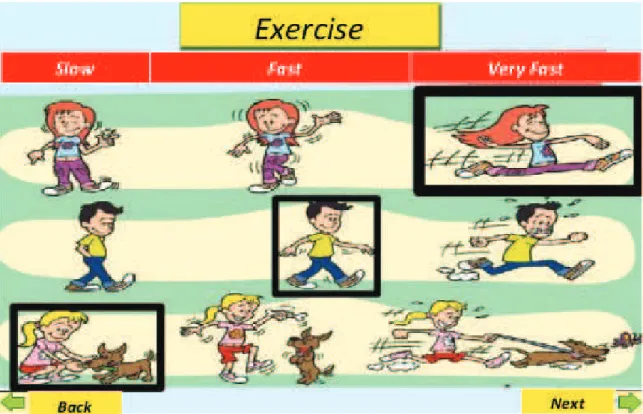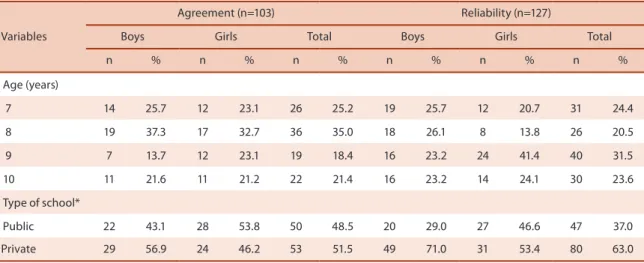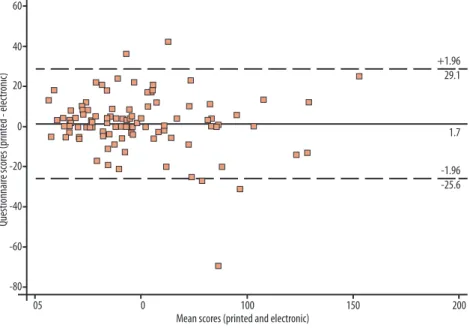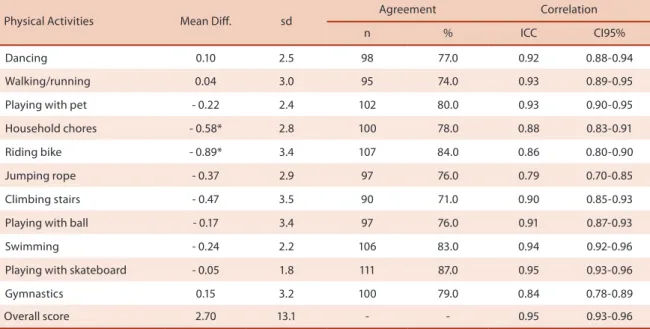RBCDH
Licence Creative Commom CC
1 Universidade Federal do Paraná, Pós-graduação em Educação Física, Curitiba, PR, Brasil.
2 Centro de Pesquisa em Exercício e Esporte da UFPR, Curitiba, PR, Brasil.
3 Universidade Tecnológica Fede-ral do Paraná, Campus Curitiba, PR, Brasil.
4 Universidade Estadual de Ponta Grossa, Ponta Grossa, PR, Brasil.
5 Universidade de Pernambuco, Escola Superior de Educação Física, Pernambuco, Brasil
6 Universidade Federal de Santa Catarina, Departamento de Nutri-ção, Florianópolis, SC, Brasil.
Received: 13 May 2012 Accepted: 20 August 2012
Agreement and reliabilty of an eletronic
questionnarie for children (WEBDAFA)
Concordância e idedignidade de um questionário
eletrônico para crianças (WEBDAFA)
Elto Legnani1,2,3
Rosimeide Francisco Santos Legnani2,4
Cassiano Ricardo Rech4
Mauro Virgilio Gomes de Barros5
Wagner de Campos1,2
Maria Alice Altenburg de Assis6
Abstract– he objective was to analyse the agreement between the printed version (PV) and electronic version (EV) of an instrument to assess PA in children and to verify the reliability between two applications of the EV. he sample included 230 seven to ten-year-old children, from two schools (public and private). he sample was divided into two groups: a) analysis of agreement (n = 130), two applications of the questionnaire (EV vs. PV); b) reproducibility analysis (n = 127), two applications of the EV (test-retest). here was no signiicant diference between the PV and PE in the PA domain (48,6 vs 46,8). he intraclass correlation coeicient (analysis of concordance) was signiicant for all types of PA (p <0.05). In the reliability analysis, the diference between the scores of PA test-retest was of 2.70, the concordance was over 70% and the intraclass correlation was 0.84 (95% CI = 0.78 to 0.89). he electronic questionnaire (WEBDAFA) presented appropriate psychometric indices of agreement and reliability when applied to children aged seven to ten years.
Key words:Physical activity; Questionnaire; Web questionnaire.
INTRODUCTION
Physical activity (PA) is associated with health beneits for children and adolescents1,2. Children who are physically active have better bone and
muscle growth3, besides presenting lower chance of developing
non-con-tagious chronic diseases such as obesity, diabetes, high blood pressure, and metabolic syndrome1-3. Evidence also suggests that behaviors acquired and
consolidated during childhood and adolescence are more likely to remain in adulthood4-6. hus, the quantiication of PA in children becomes
impor-tant in order to identify its prevalence and also to diagnose AP patterns of population subgroups.
Objective measurements of PA such as direct observation, accel-erometry, pedometers, and energy expenditure are accurate and valid in children, however, they are costly and require speciic equipment, which limits their application in epidemiological studies7-9. Subjective
measures such as questionnaires, interviews, and diaries based on the self-report of a child or parent are widely used to measure PA8,9.
How-ever, the use of questionnaires to assess the habitual practice of PA in children has limitations because children are involved in spontaneous and intermittent activities, which can result in errors of recall bias in the self-report of PA10,11, not to mention that there are few valid tools
for this population.
In an attempt to minimize these errors and possible misunderstand-ings in the interpretation of complex questions, questionnaires to assess PA in children have used speciic tools with appropriate language for this public12. In Brazil, the questionnaire typical day of PA and food intake
(DAFA, in Portuguese) is the only tool developed and validated speciically for Brazilian children of ages between seven and ten years old. his tool identiies the PA done during a typical day based on illustrative drawings, making the evaluation more attractive and less complex for children12. he
PA section of this tool was validated based on the reports from parents and teachers12.
Recently studies have used electronic questionnaires via internet to measure diferent outcomes related to health13-16. It is believed that this
type of application can be more attractive among children and result in more accurate values to measure PA17. Further advantages relate to
inancial savings because it eliminates the printing of the questionnaires, it saves time, and it is also possible to apply the tool at diferent locations simultaneously. his technology gives direct access and greater accuracy in the collection and storage of the data13,18. Despite all these beneits
listed above, studies conducted in Brazil were not found in the literature that have evaluated the agreement and reliability of electronic tools for measuring PA in children.
obtained, the present study presents the following objectives: analyze the agreement of the measurements of PA in children obtained by applying the printed version (PV) of the DAFA questionnaireversus the electronic version of the WEBDAFA (EV) questionnaire, as well as check the reliabil-ity (test-retest) of the PA measurements obtained through the WEBDAFA electronic questionnaire in children.
METHODOLOGICAL PROCEDURES
Study Proile
We selected 230 children between the age of seven and ten who were en-rolled in two schools (one public and one private). In each school two groups were selected: a) concordance analysis (n=130) and b) the reproducibility analysis (n=127). he selection of the schools was done intentionally. Eight groups were randomly selected in each school (1st through 4th grade), two from each grade, and all students from each group selected were invited to participate in the study (n=400). Ater sending consent forms, 250 (return rate of 57.5%) of these returned and 20 of these students were excluded because they were over 10 years old.
In the analysis of the agreement, the students irst answered the PV and then latter the EV. he reliability was checked by applying the electronic tool on two occasions. he interval between applications was of one day for the procedures of agreement and test-retest, respectively. he data collection procedures were conducted between the months of October and November 2010 in a computer lab room under the guidance of the researcher and supervision of the teacher responsible for the class.
In the application of both tools, the researcher presented the ques-tionnaire to the students with a concise explanation of all the sections, highlighting the concept of a typical day, meaning the PA done on most days of the week12 using a vocabulary appropriate for the age group of
children and gestures to emphasize the actions and with the help of a projector of images.
Application of printed tool
he printed tool used as the reference method was the DAFA (Typical Day of Physical Activities and Food Intake) questionnaire, which is a structured questionnaire developed with the purpose of obtaining information about the PA habits of a typical day and the Food Intake of children between the ages of seven and ten years old. It was tested with Brazilian schoolchildren and presented adequate psychometric measurements of validity and re-producibility for measuring PA12. his study’s project was approved by the
Ethics Committee on Human Research at the State University of Western Paraná (decision 494/2010).
study will present the results regarding the PA section. he representation of each type of PA is done by means of 11 drawings that indicate each category (dancing, walking, playing with a pet, doing household chores, riding a bike, jumping rope, climbing stairs, playing ball, swimming, skateboarding, and doing gymnastics or stretching) and intensity (slow, fast, and very fast) of the PA. In the analysis of the physical activity of each category, a value was assigned for each intensity, slow (=3), fast (=5), and very fast (=9), which can generate scores by category as follows: (0) zero for children who said they had not done any physical activity and 3.5 or 9 for children who marked only one of the three intensities. In the other cases the possibilities of the PA scores would be as follows: 8 (slow + fast), 12 (slow + very fast), 14 (fast + very fast), and 17 (slow + fast + very fast). he overall score of PA would be the result of the sum of all categories of PA, which may result in a PA overall score of 187 presented in the tool. To apply the printed tool we followed the guidelines proposed in the original study12.
Application of Electronic tool (internet)
he EV of the Typical Day of Physical Activities and Food Intake) ques-tionnaire, named by the authors as Webdafa, was developed through an internet (web) application that used the programming language Hypertext Preprocessor 5 (PHP 5)19, Java Script20. It has a graphical interface where
users interact using Adobe Flash technology21. he project is hosted
on the site http://www.criancaativaesaudavel.com.br and the form can be accessed through web browsers (Internet Explorer, Mozilla, Google Chrome).
The Webdafa consists of the same structure of the printed tool, differing in only the interface mode for filling out the answers. A man-agement system was added of a database adopted for storing informa-tion via the MySQL 5 method19,22, which makes it possible to generate
reports that can be exported to spreadsheets in Excel for Windows (xls). In order to submit answers in the electronic version, the children were instructed to move the mouse’s cursor over the picture and double click on it (Figure 1).
Analysis of data
he information on the printed questionnaire (DAFA) was entered into the program Epidata 3.1 and inconsistencies checked by the double entry method. he data from the Webdafa questionnaire were obtained from a spreadsheet from the Excel for Windows program generated by the elec-tronic MySQL5 system19.
this non-parametric tests were used to compare the groups. here was no signiicant diference (p<0.05) between the scores of PA according to gender and type of school so the analyses were performed grouped. he comparison between the percentages was obtained by the chi-square test.
he agreement was analyzed by comparing the mean of the scores (mean scores of posts) obtained by the printed and electronic versions. Individual analyses were done per question and by the overall PA score through the Mann-Whitney U test. Furthermore, the intraclass correla-tion coeicients and the percentage of agreement between the answers of the irst and second application were used. he overall score of PA was obtained by adding the scores of each type of PA. he dispersion was tested between the methods by the Bland and Altmann test23. he Kappa test was
used to analyze the agreement between the classiications obtained from both methods and because of this the overall score was dichotomized in relation to the median.
For the reliability analysis, the mean diference was checked between the scores of the electronic questionnaire Webdafa obtained on two oc-casions (test-retest) through the Mann-Whitney U test. he percentage of agreement and intraclass correlation coeicient were also employed in this analysis.
Ethical aspects
All participants in the study were volunteers and the parents or guard-ians signed the informed consent form authorizing participation in the
study. he methodological procedures used in this study were analyzed and approved by the Ethics Committee on Human Research at the State University of Western Paraná (decision 494/2010).
RESULTS
he study sample consisted of two groups from public (42.2%) and private schools with the following characteristics: age of 8.4 years (sd=1.1 years), height of 1.30 m (sd=0.7), body mass of 32.1 kg (sd=7.1), and body mass index of 17.4 kg/m 2 (sd=2.6). he sample of agreements was composed of
103 children (50.5% girls) with a predominant age of eight years old. he reproducibility sample was composed of 127 children (45.7% girls). In this sample a higher proportion of girls from public schools and overweight was observed in relation to the number of boys (p<0.05). Other characteristics of the sample are presented in table 1.
Table 1. Descriptive characteristics of the sample in the study of agreement and reliability of the electronic questionnaire WEBDAFA applied to children ages seven to ten years old.
Variables
Agreement (n=103) Reliability (n=127)
Boys Girls Total Boys Girls Total
n % n % n % n % n % n %
Age (years)
7 14 25.7 12 23.1 26 25.2 19 25.7 12 20.7 31 24.4
8 19 37.3 17 32.7 36 35.0 18 26.1 8 13.8 26 20.5
9 7 13.7 12 23.1 19 18.4 16 23.2 24 41.4 40 31.5
10 11 21.6 11 21.2 22 21.4 16 23.2 14 24.1 30 23.6
Type of school*
Public 22 43.1 28 53.8 50 48.5 20 29.0 27 46.6 47 37.0
Private 29 56.9 24 46.2 53 51.5 49 71.0 31 53.4 80 63.0
* Diference between genders p <0.05 (chi-square) in reliability sample.
There was no significant difference between the PA scores obtained from the PV versus the EV (Table 2). The intraclass correlation coef-ficient was significant for all types of PA (p<0.05), ranging from 0.79 (household chores) to 0.93 (swimming). Among the 11 types of PA analyzed, only the items playing ball (25.2%), jumping rope (36.8%), and swimming (41%) showed relative agreement of less than 70%. However there was high agreement (88.3%) of the overall score of PA and a kappa index of 0.76 (p<0.001) when comparing the questionnaires printed versus electronic (data not shown). The dispersion analysis (figure 2) indicated a mean error of 1.7 (CI95% = -25.6; 29.1). PA scores, low and medium, showed good agreement, but the higher scores presented higher dispersion.
(riding bicycle) and 0.95 (playing with a skateboard). here was a signiicant diference (p<0.05) in the PA scores between the two applications of the EV of the WEBDAFA questionnaire only for the types of PA “household chores and riding bicycle” (table 3).
Table 2. Average scores of the physical activities, agreement, and correlation between the questionnaire’s printed and electronic versions to measure physical activity in children ages seven to ten years old (n=103).
Physical Activities
Scores
Agreement Correlation
PV EV
Mean Sd Mean Sd n % ICC CI95%
Dancing 3.6 4.3 3.4 3.9 86 83.6 0.85 0.78-0.90
Walking/running 5.9 4.6 3.0 4.9 74 71.8 0.85 0.77-0.89
Playing - pet 4.7 5.1 4.0 4.5 83 80.5 0.87 0.82-0.91
Household chores 4.2 4.7 4.3 4.7 72 70.0 0.79 0.70-0.86
Riding bike 4.5 4.6 5.1 5.0 75 72.8 0.81 0.73-0.87
Jumping rope 2.3 3.9 2.7 3.8 38 36.8 0.80 0.71-0.86
Climbing stairs 5.0 5.0 4.5 4.7 80 77.6 0.90 0.86-0.93
Playing with ball 6.4 5.5 6.0 5.6 26 25.2 0.91 0.87-0.94
Swimming 4.8 5.7 4.1 5.3 42 41.0 0.93 0.89-0.95
Playing with skateboard 3.0 4.9 2.7 4.4 82 79.6 0.86 0.78-0.90
Gymnastics 3.7 4.5 3.5 4.4 87 84.4 0.81 0.87-0.94
General 48.6 29.1 46.8 30.6 - - 0.94 0.91-0.96
* There was no diference between the application methods (Mann-Whitney U). p<0.05. ICC: Intraclass Correlation Coeicient. CI95%: conidence interval. Abbreviations: PV - Printed Version; EV - Electronic Version.
+1.96 29.1
-1.96 -25.6 1.7 60
40
20
-20
-40
-60
-80
05 0 100
Mean scores (printed and electronic)
Questionnai
re
scor
es (printed - elec
tr
onic)
150 200
0
Table 3. Analysis of reliability (test-retest) of applying the WEBDAFA electronic questionnaire to measure physical activity in children ages 7-10 years old (n=127).
Physical Activities Mean Dif. sd
Agreement Correlation
n % ICC CI95%
Dancing 0.10 2.5 98 77.0 0.92 0.88-0.94
Walking/running 0.04 3.0 95 74.0 0.93 0.89-0.95
Playing with pet - 0.22 2.4 102 80.0 0.93 0.90-0.95
Household chores - 0.58* 2.8 100 78.0 0.88 0.83-0.91
Riding bike - 0.89* 3.4 107 84.0 0.86 0.80-0.90
Jumping rope - 0.37 2.9 97 76.0 0.79 0.70-0.85
Climbing stairs - 0.47 3.5 90 71.0 0.90 0.85-0.93
Playing with ball - 0.17 3.4 97 76.0 0.91 0.87-0.93
Swimming - 0.24 2.2 106 83.0 0.94 0.92-0.96
Playing with skateboard - 0.05 1.8 111 87.0 0.95 0.93-0.96
Gymnastics 0.15 3.2 100 79.0 0.84 0.78-0.89
Overall score 2.70 13.1 - - 0.95 0.93-0.96
* It difers p<0.05 (Mann-Whitney U). ICC: intra-class correlation coeicient (p>0.05). CI95%: conidence interval. Mean Dif. = mean diference (T1 - T2).
DISCUSSION
he analysis of agreement between the printed and electronic methods showed signiicant intraclass correlation values for most items analyzed (ICC> 0.79). he overall PA score obtained by the two methods did not dif-fer statistically, indicating agreement between the methods. he reliability analysis indicated an agreement percentage higher than 70% and a high intraclass correlation coeicient (ICC> 0.84) for all items of the electronic tool. Among the 11 categories of PA, only three had mean scores that dif-fered (p<0.05). his indicates appropriate values of reliability for the tool applied in the electronic version on children.
he Webdafa tool was designed based on the use of new electronic technologies to collect health-related information. he mode of application aroused the interest of the child to answer the tool and to ill it out was fun and fast. he electronic application of the tool has advantages such as how to eliminate the cases missing from the analysis. here is no need to enter the results from the questionnaires into the database, thus eliminating the chance of typing errors, saving time in applying the questionnaire, and the data can be available in real time via internet for diferent locations. hese advantages listed have encouraged some researches and surveys via internet with various health-related outcomes24,25 .
In general, tools to assess PA in an electronic format arouse the inter-est in children the most25-29. In general, when analyzed individually, the
electronic questionnaires are more reliable estimates for the PA of groups than the individual estimates28,29.
Although this study did not conduct objective measures of PA, no dif-ferences were observed between the sum of the PA scores obtained by the printed questionnaire versus the electronic questionnaire. Even when the analyses were made between gender, these results corroborate with studies done previously with this type of tool25,27,29.
In the reliability analysis, the Webdafa electronic questionnaire showed intraclass correlation coeicients between 0.73 to 0.93. his data is superior to those found in the original version, which ranged from 0.50 to 0.8330.
In general, electronic questionnaires have shown high intraclass correla-tion coeicients17,28,29. his demonstrates that electronic questionnaires
have a good internal consistency and stability, which suggests that they are promising to use in epidemiologic surveys because it is an inexpensive method, viable, and useful for monitoring levels (behavior) of habitual PA of children by group level.
Currently a signiicant proportion of schools in southern and southeast-ern Brazil have computers connected to the worldwide network, which can provide a large number of children with immediate access to the Webdafa electronic questionnaire with relative ease. In theory, researchers from vari-ous regions of Brazil could investigate the PA in children simultanevari-ously. hus, we suggest that further studies be conducted using the Webdafa questionnaire with diferent population groups.
he intentional selection of schools and classes, the short period be-tween the irst application (test) and second application (retest), as well as the lack of a reference measurement for validating the PA scores obtained by the electronic questionnaire may be considered the main limitations of this study. herefore, we recommend that further studies of agreement and validation of the WEBDAFA questionnaire be done in other regions of Brazil with children from diferent social classes, especially where they do not have much familiarity with computers. Because of this, the results of this study should be treated with caution and cannot be extrapolated to other regions of Brazil.
CONCLUSION
Finally, it is concluded that the Webdafa questionnaire applied in its electronic form presented values of agreement and reliability suitable for measuring PA in children between seven and ten years old.
REFERENCES
1. Hallal PC, Victora CG, Azevedo MR, Wells JCK. Adolescent physical activity and
health: a systematic review. Sports Med 2006;36(12):1019-30.
2. Twisk JWR. Physical activity guidelines for children and adolescents: a critical
review. Sports Med 2001;31(8):617-27.
3. Janssen I. Physical activity guidelines for children and youth. Appl Physiol Nutr
4. Azevedo MR, Araújo CL, Silva MC, Hallal PC. Tracking of physical activity from adolescence to adulthood: a population-based study. Rev Saude Publica 2007;41(1):69-75.
5. Boreham C, Robson PJ, Gallagher AM, Cran GW, Savage JM, Murray LJ. Tracking
of physical activity, itness, body composition and diet from adolescence to young adulthood: he Young Hearts Project, Northern Ireland. Int J Behav Nutr Phys Act 2004;1(1):1-14.
6. Gordon-Larsen P, Nelson MC, Popkin BM. Longitudinal physical activity and
seden-tary behavior trends: Adolescence to adulthood. Am J Prev Med 2004;27(4):277-83.
7. Kohl HW, Fulton JE, Caspersen CJ. Assessment of physical activity among children
and adolescents: a review and synthesis. Prev Med 2000;31(2):S54-S76.
8. Sallis JF, Saelens BE. Assessment of physical activity by self-report: status, limita-tions, and future directions. Res Q Exerc Sport 2000;71(2 Suppl):S1-14.
9. Farias Júnior JC, Lopes AS, Florindo AA, Hallal PC. Validity and reliability of
self-report instruments for measuring physical activity in adolescents: a systematic review. Cad Saúde Pública 2010;26(9):1669-91.
10. Cale l, Harris J. Self-report measures of children’s physical activity: recommen-dations for future development and a new alternative measure. Health Educ J 1994;53:439-53.
11. Welk GJ, Corbin CB, Dale D. Measurement issues in the assessment of physical
activity in children. Res Q Exerc Sport 2000;71(2 Suppl): S59-73.
12. Barros MVG, Assis MAA, Pires MC, Grossemann S, Vasconcelos FAG, Luna MEP,
et al. Validity of physical activity and food consumption questionnaire for children aged seven to ten years old. Rev Bras Saude Mater Infant 2007;7(4):437-48.
13. Davis RN. Web-based administration of a personality questionnaire: Comparison
with traditional methods. Behav Res Methods 1999;31(4):572-7.
14. Resiti TMP, Annelette WM, Johan EVDBR, Harry VDL, Hein J de K, Hein R.
Internet-administered adolescent Health questionnaires compared with a paper version in a randomized study. J Sch Health 2005;36:70.e1-70.e6.15.
15. Ekman A, Dickman PW, Klint A, Weiderpass E, Litton JE. Feasibility of using
web-based questionnaires in large population-based epidemiological studies. Eur J Epidemiol 2006;21(2):103-11.
16. Mangunkusumo RT, Duisterhout JS, de Graaf N, Maarsingh EJ, de Koning HJ,
Raat H. Internet Versus Paper Mode of Health and Health Behavior Questionnaires in Elementary Schools: Asthma and Fruit as Examples. J Sch Health 2006;76:80-6.
17. Ridley K, Dollman J, Olds T. Development and validation of a computer
deliv-ered physical activity questionnaire (CDPAQ) for children. Pediatr Exerc Sci 2001;13(1):35-46.
18. Bälter KA, Bälter O, Fondell E, Lagerros YT. Web-based and mailed questionnaires: a comparison of response rates and compliance. Epidemiology 2005;16(4) 577-9.
19. Welling L. PHP e MySQL desenvolvimento Web. Elsevier; 2005.
20. Powers S. Learning JavaScript. O’Reilly Media, Inc; 2006.
21. Adobe Flash. Available from: <http://pt.wikipedia.org/wiki/Adobe_Flash> [2011 ago 31].
22. Williams HE, Lane D. Web database applications with PHP & MySQL. O’Reilly
& Associates, Inc; 2004.
23. Martin Bland J, Altman DG. Statistical methods for assessing agreement between
two methods of clinical measurement. Lancet 1986;327(8476):307-10.
24. Woodruf SJ, Hanning RM, McGoldrick K, Brown KS. Healthy eating index-C is
positively associated with family dinner frequency among students in grades 6–8 from Southern Ontario, Canada. Eur J Clin Nutr 64(5):454-60.
25. Moore HJ, Ells LJ, McLure SA, Crooks S, Cumbor D, Summerbell CD, Batterham
Corresponding author
Elto Legnani
Rua: Luiz Barreto Murat, nº. 915 S-5 - Bairro Alto.
Cep: 82820-160 – Curitiba, PR. Brasil E-mail: legnanielto@hotmail.com
26. Lévesque L, Cargo M, Salsberg J. Development of the Physical Activity Interactive Recall(PAIR) for Aboriginal children. Int J Behav Nutr Phys Act 2004;1(1):1-8.
27. McMurray RG, Harrell JS, Bradley CB, Webb JP, Goodman EM. Comparison of a
computerized physical activity recall with a triaxial motion sensor in middle-school youth. Med Sci Sports Exerc 1998;30(8):130-9.
28. Ridley K, Olds TS, Hill A. he Multimedia activity recall for children and
ado-lescents (MARCA): development and evaluation. Int J Behav Nutr Phys Act 2006; 3(1):1-10.
29. Mclure SA, Reylly JJ, Crooks S, Summerbell CD. Development and evaluation of a
novel computer-based tool for assessing physical activity levels in schoolchildren. Pediatr Exerc Sci 2009;21(4):506-19.
30. Da Costa FF, Assis MAA. Nível de atividade física e comportamentos sedentários



